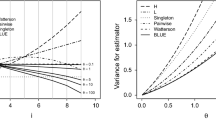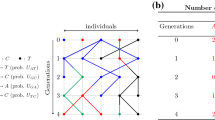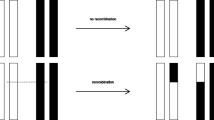Abstract
Two methods are discussed for evaluating the distribution of the configuration of unlabeled gametic types in a random sample of size n from the two-locus infinitely-many-neutral-alleles diffusion model at stationarity. Both involve finding systems of linear equations satisfied by the desired probabilities. The first approach, which is due to Golding, is to include additional probabilities in the system that allow some members of the sample to be specified at only one locus. The second approach, which is new, considers the joint distribution of the sample configuration and the number of recombination events since the time of the most recent common ancestor. The first approach is used for numerical computation, whereas the second approach is used to derive a two-locus version of Hoppe's urn model. The latter permits efficient simulation of the two-locus sampling distribution, provided the recombination parameter is not too large.
Similar content being viewed by others
References
Ethier, S. N., Griffiths, R. C.: The infinitely-many-sites model as a measure-valued diffusion. Ann. Probab. 15, 515–545 (1987)
Ethier, S. N., Griffths, R. C.: The neutral two-locus model as a measure-valued diffusion. Adv. Appl. Prob. 22, to appear (1990)
Ewens, W. J.: The sampling theory of selectively neutral alleles. Theor. Popul. Biol. 3, 87–112 (1972)
Golding, G. B.: The sampling distribution of linkage disequilibrium. Genetics 108, 257–274 (1984)
Griffiths, R. C.: Neutral two-locus multiple allele models with recombination. Theor. Popul. Biol. 19, 169–186 (1981)
Griffiths, R. C.: The two-locus ancestral graph. In: Basawa, I. V. (ed.) Selected Proceedings of the Symposium on Applied Probability, Sheffield. IMS Lect. Notes-Monograph Ser. 1990, to appear
Hoppe, F. M.: Pó1ya-like urns and the Ewens sampling formula. J. Math. Biol. 20, 91–94 (1984)
Hudson, R. R.: The sampling distribution of linkage disequilibrium under an infinite allele model without selection. Genetics 109, 611–631 (1985)
Hudson, R. R., Kaplan, N. L.: Statistical properties of the number of recombination events in the history of a sample of DNA sequences. Genetics 111, 147–164 (1985)
Kaplan, N. L., Hudson, R. R.: The use of sample genealogies for studying a selectively neutral m-loci model with recombination. Theor. Popul. Biol. 28, 382–396 (1985)
Strobeck, C., Morgan, K.: The effect of intragenic recombination on the number of alleles in a finite population. Genetics 88, 829–844 (1978)
Author information
Authors and Affiliations
Additional information
Supported in part by NSF grants DMS-8704369 and DMS-8902991
Rights and permissions
About this article
Cite this article
Ethier, S.N., Griffiths, R.C. On the two-locus sampling distribution. J. Math. Biol. 29, 131–159 (1990). https://doi.org/10.1007/BF00168175
Received:
Revised:
Issue Date:
DOI: https://doi.org/10.1007/BF00168175




